Eating through Singapore, Bangkok and Saigon, in search of the soul of street food
The worst meal I ever ate in Southeast Asia was at a beautiful candlelit restaurant in Bangkok. The waiters wore sarongs and offered lemongrass-scented towels to wash off the day. Back in the kitchen, the chef, a young European, had taken to reinterpreting traditional Thai food, adding modern twists and foreign “refinements”—replacing chicken with duck confit, daubing noodles with foie. It was twice as expensive and half as good as any other meal I ate on that trip (including the tame farang fare of the island bungalow circuit). Later that same night, I went out and ate the dishes the young chef was trying to approximate and promised myself to never eat inside a real restaurant in this part of Asia again.
That experience, coupled with other letdowns over the past decade of travel to the Far East, helped form the basis of what I’ll call the Pretty=Shitty Postulate: That is, the more attractive the restaurant in Southeast Asia, the less likely it is to serve delicious food. There are, of course, exceptions to the rule, but they are shockingly scarce. No, to eat well in this part of the world, look for the establishment with the tiny plastic stools, the gathering insects, the fluorescent glare of a hospital waiting room.
While you’re at it, might as well skip the place with the credit card machine and the his and hers bathrooms. And there’s really no use for that team of waiters. Or even a menu. Come to think of it, what you’re really looking for is a stretch of cement with just enough room for a few plastic stools and a raging fire. That’s where the good stuff is.
By a sheer stroke of culinary providence, I found myself in Asia this spring with an itinerary that included just three stops: Singapore, Bangkok, and Saigon. Bound by more than just silty rivers and punishing heat, these lions of Southeast Asia may also be the three finest street food civilizations on the planet.
Street food is big news these days. Guidebooks dedicate entire sections to street food safety, tour operators take westerners to not-so-secret locations to observe this exotic style of eating, and vast blogging communities busy themselves with mapping out the best of a city’s sidewalk offerings. All the while, the Western world tries to find a way to make it theirs. Some people buy trucks and pass black bean burgers and Korean tacos through the window. The more ambitious ones, the chefs with names you might recognize, make the pilgrimages to these cities, often with their team of underlings in tow, where they eat and eat and eat. Back in their spotless kitchens, they set about recreating the stars of the street scene with impressive precision and first-class products. They add that garnish of fried shallots they tried in the Chiang Mai market; they serve their shrimp with lime and black pepper like it’s done in Hanoi. But when you bite into that $19 “small plate”? It is fine. It is perfectly satisfying.
But it isn’t street food. Not even close.
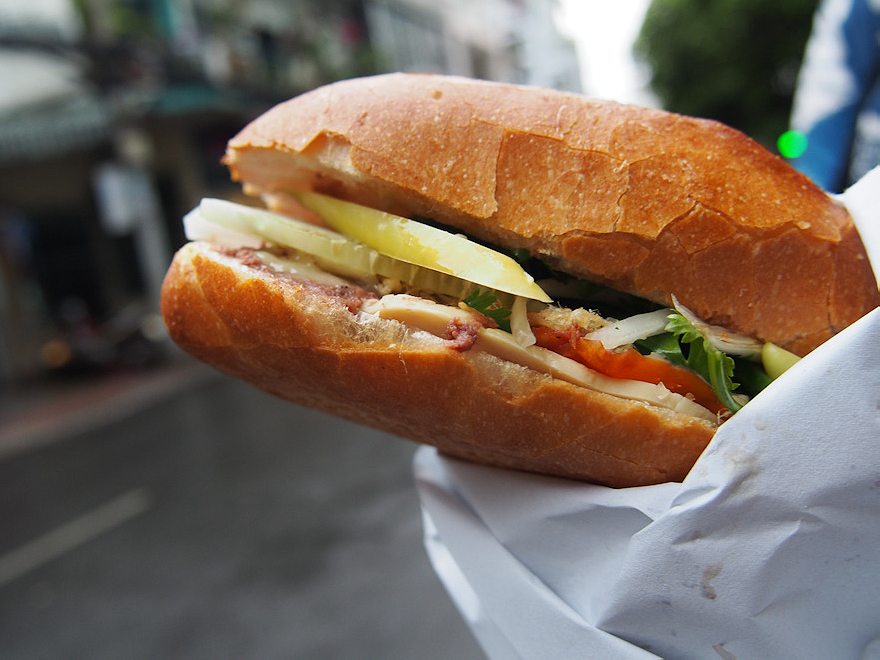
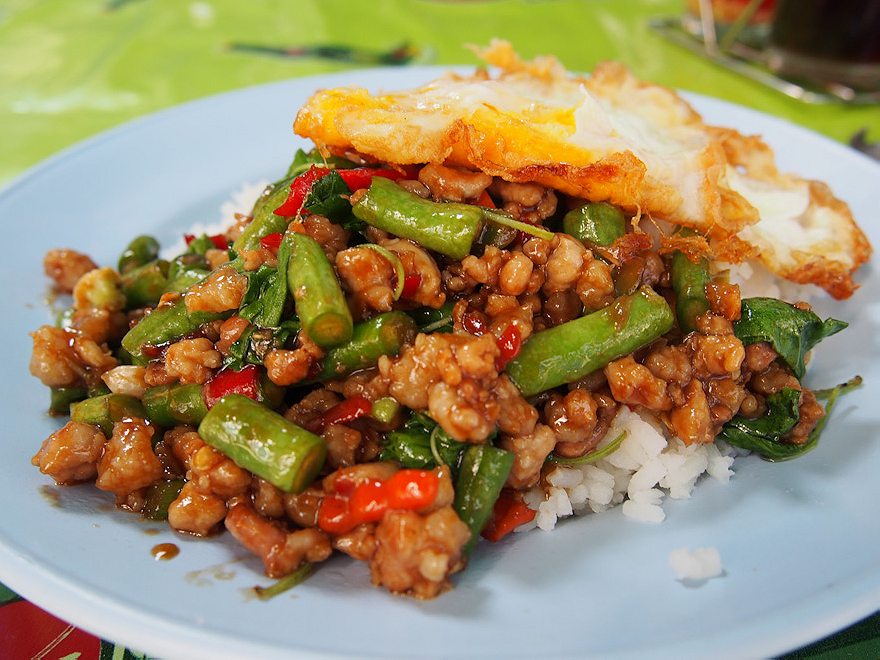
Considering all the noise, I figured it was time to take the temperature of this feverish global phenomenon. This wouldn’t be an exhaustive report on the best and the brightest of the region; it would take many lifetimes to ever truly gain a comprehensive understanding of these dense ecosystems (that being said, the key to understanding and interpreting the specific tastes of a given city lies in the networks of bloggers who live there, writers like Graham Holliday in Vietnam or Austin Bush in Thailand have been heroically cataloging street eats for years). No, this would be a journey into the wok-fired heart of street cuisine, a time to feast on asphalt chased with fish sauce and exotic fruit juices. To sit elbow to elbow with a million other hungry, sweaty humans and consume in hushed reverence. To free myself from the tyranny of candle lights and lemongrass towels.
And with any luck, after enough noodles have been slurped and enough stir-fries devoured, to learn what lies at the soul of a form of dining as ancient as dining itself.
![]()
I’ve never bought into the idea that cab drivers are fountains of reliable culinary advice. Too many mediocre meals in depressing haunts. But if the Singaporean cabbie association published their own Michelin guide, I’d be the first in line to snatch it up.
Take this conversation, had on my first afternoon in Singapore:
“Where you going?”
“Old Airport Road.”
“The hawker market? Good choice.”
“Yeah? What’s good there?”
“Well, let me think. I’d go to Xin Mei Xiang. The queue for their lor mee gets long, so best to start there…Nam Sing does one of the better fried mee in Singapore. Three kinds of noodles. I’d go there next…Skip the satay place with the queue upstairs—too sweet. Instead, grab a few curry puffs from the Wang Wang stand…That’s how I’d do it.”
He doesn’t just offer a few favorites; he explains their virtues in poetic detail: how lor mee should slip through the mouth like a bowl of warm gelatin, how in a proper Hokkein mee, like the one made by Nam Sing, the squid is cut to mimic the shape of the noodles, how the buttery puff pastry pocket makes for the perfect foil to the spicy potato curry stuffed inside.
I do exactly what he tells me, following his instructions to the letter: squeezing the lime and stirring the chilies into the fried mee; bearing the volcanic heat of the brooding lor mee broth to get to the noodles before they’re compromised by the scalding liquid; packing a pair of curry puffs away in my bag for a midday snack. Later, I make good on a promise and send him photos of the meal, not because he’s interested in seeing the food, I suspect, but because he wants to make sure I didn’t screw it up. He responds with two words: “Not bad.”
Singapore claims more food magazines per capita than any other on Earth.
Few people on the planet care as much about what they eat as Singaporeans. To start with, the proper way to greet someone in Singapore isn’t “hello, how are you?”, but “have you eaten yet?” This is foodie-ism in its most extreme iteration: The country claims more food magazines per capita than any other on Earth, blogs teem with prickly debates about the nuances of laksa broth and chicken rice condiments, and the lines that snake from Singapore’s most famous food stalls can make New York Cronutmania seem like a cake walk.
For further proof of Singapore food fanaticism, look no further than Leslie Tay, one of the most respected of Singapore’s legions of street-food scribes, whose website ieatishootipost.sg is a lush repository of gorgeous photography and forcefully-argued food rankings. But Tay isn’t a writer or photographer by trade, but rather a practicing pediatrician, who in his fleeting moments of spare time likes to break down dishes the way a doctor breaks down a blood sample. (His motto: “Never waste calories on yucky food.”)
We meet one night at the East Coast Lagoon Food Village, a seaside collection of food vendors with a dense concentration of satay specialists. Not more than 20 meters from the sand and the Singapore Strait, you’ll find a long line of satay cooks positioned in front of narrow charcoal grills, tending to their grills with a mix of art of science: shuffling and flipping the sticks between their hands like three-card Monte hustlers, all the while waving their accordion fans in sweeping arcs, from high above their head right down to the teeth of the grill, bathing their satay in thick plumes of smoke. It looks like a mating ritual as much as a cooking technique, and it’s the kind of display you’ll never find in a restaurant. Street food, after all, is a spectator sport.

We settle on Haron 30 Satay, Tay’s favorite at East Coast, and the grill man sends us off with a stack of 20 sticks. The skewers are strewn with bite-size chunks of chicken thigh, and the combination of the sugars in the marinade and the intensity of the fire creates a beautiful patchwork of char on the surface of the bird—which emerges from its brief, smoky stint on the grill juicier and more intensely flavorful than chicken has any right to be. There’s a thick, slightly sweet peanut sauce for dipping, and a pile of cucumbers and raw onions to refresh the palate, but I’m eight sticks deep before I even notice.
We share an oyster omelet for dessert, which Tay, who has come directly from his practice to dinner, calls a “cholesterol bomb”, but which doesn’t deter either of us from jabbing at it violently with our chopsticks. A mix of beaten egg, potato starch and raw shellfish, it recalls the Hangtown fries that kept prospectors sated during the California Gold Rush. “It’s about the different textures of the egg,” says Tay. “The crispy outside, the custardy center.”
After eating, we survey the rest of the stands. Tay greets some of the vendors, pokes around, asks specific questions about wok temperatures and sauce proportions. Most questions are met with little more than generous smiles.
“It’s not that they don’t want to talk,” says Tay. “These guys just don’t know about the ‘why’. They just know that if they don’t do it like they did it yesterday, something will go wrong.”
Predictably, no one has been as stringent about the rules as the Singaporean government.
There are stands dedicated solely to chicken wings, to grilled shellfish, to wok-fried sea snails and barbecued stingray. “The variety is staggering,” says Tay, who puts out an app that breaks Singaporean street food down into 66 categories. Singapore has long been a cultural crossroads in southern Asia, and its cocktail of Malay, Indian and southern Chinese citizens has blessed the kitchens with a staggering variety of regional specialties and multi-cultural mashups. “It’s what defines Singapore food. At every stand you have someone focusing on one dish. How many of the world’s greatest chefs have that kind of patience?”
These are the hallmarks of street food: strong flavors, tight menus, food prepared in full view of the customer by people who specialize in a single dish. And yet, it’s not quite street food. In 1950s and 60s, the Singapore government began to move the vendors off the street and into covered centers—the better to regulate basic health and sanitary conditions. The result is a vast network of multi-tiered hawker centers strewn throughout the city, sprawling food courts that house dozens if not hundreds of individual entrepreneurs who create their food under controlled conditions.
Safety has become an increasing concern for diners and local governments as street food popularity grows. The Food Safety Agency in Vietnam recently found that 23 percent of street food samples tested contained dangerous microorganisms. Efforts have been made across Southeast Asia to bring some form of safety and regulation to the freewheeling industry, but, predictably, no one has been as stringent about the rules as the Singaporean government. As a result, Tay calls this “one of the safest places in the world to eat street food.” But not everyone sees the upside.
“It’s unfortunate. Something got lost in the move from the street into the centers,” says Daniel Ang, the man behind DanielFoodDiary.com, another one of Singapore’s excellent street food blogs. He tells me this at lunch at the Hong Lim Food Centre in Chinatown over a plate of Hokkien mee. For someone just off the plane from Spain, where flavors feel muted by comparison, the dish—a surf-and-turf combination of pork- and shrimp-strewn noodles swimming in a garlicky, chili-spiked gravy—makes me wonder what it could have possibly lost. But Ang is not alone in his assessment.
If you take the food out of the street, do you take the street out of the food?
After the first round of food, we speak with Michael Tan, owner of the Old Stall Hokkien Street Famous Prawn Mee. “The government gave us an incentive to move inside. But it’s not the same, it’s not as spontaneous.” Ang and Tan talk wistfully about Bangkok, how the simmering street environment creates more exciting flavors, how the sites and the sounds make for more memorable meals.
So Singaporean food may have lost a bit of its bite, but both men agree there’s a bigger problem on the horizon: a crisis of cooks. Street food has always been a family business, with stalls being passed down from one generation to the next, but as the city-state grows more prosperous, young Singaporeans are more likely to take up jobs as investment bankers and ad men than satay grillers and mee fryers.
Suddenly, the future doesn’t look so unequivocally delicious. Questions abound. Will Singaporean technocrats suck the soul out of street food? Does Big Brother dig on chicken rice? If you take the food out of the street, do you take the street out of the food?
And if the government doesn’t neuter street food, will the sons and daughters of Singapore hawkers let it die slowly?
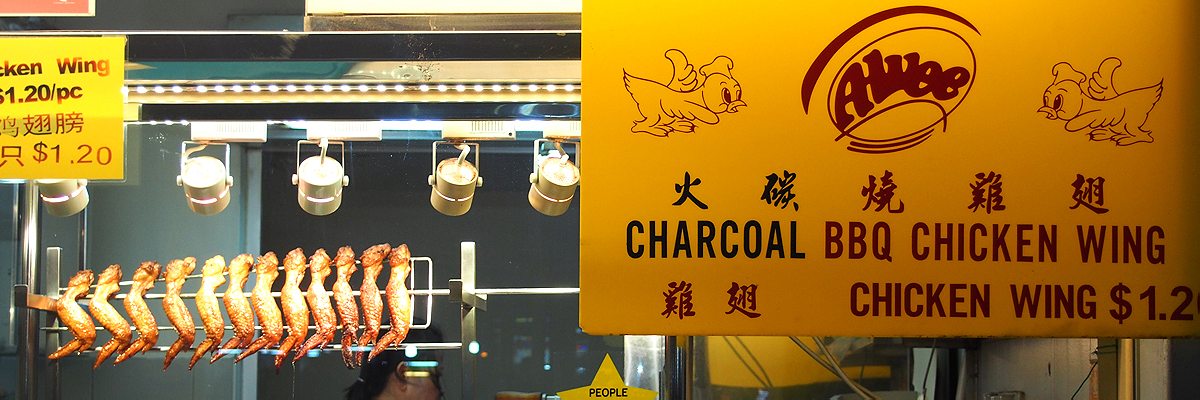
Wrestling with all of this threatens to zap my appetite, but then Daniel takes me to Hong Lim’s most famous stand, Outram Park Fried Kway Teow Mee, where the family still cooks the Chinese-Malay staple in a wok set over a crackling charcoal fire. You can taste the difference—not just in the subtle hits of smoke that perfume the dish, but in the rogue chunks of crispy pork fat and the light sheen of gently cooked egg that covers the noodles like a textbook Chinese carbonara.
The genius behind the creation, Ng Chin Chye, has been cooking char kway teow for nearly 50 years, the first four decades at the elbow of his father, the last on his own, with his wife dolling out his creation to the masses. When he adds his special brew of soy sauce and fish sauce to the noodles, he methodically counts it out from his squeeze bottle: 42 squeezes, just like Dad used to do. But who will be there to stoke the charcoal and squeeze the sauce when his days of char kway teow come to an end?
For now, the line he commands curls around half the second floor of the complex. The hardest work has already been done. If someone wants to man the wok, they’ll have an entire country line up for them.
![]()
The first thing I do in Bangkok is the first thing everyone does when they come to Bangkok: I get lost.
I spent weeks doing research, emailing experts, marking maps, setting up interviews—doing what I would normally do before eating my way though a town. Only, when the bus doors open and spit me out into that cauldron of spice and sin, all of the preparation evaporates into the warm city air. In Bangkok, where the best places to eat come without names or addresses, you can’t Google your way to the promised land; you just need to feel it out.
As someone accustomed to planning Thursday’s lunch before Monday’s breakfast is fully digested, this takes time and patience and a considerable surrendering of compulsive behavior. But once you accept the reality, there is something deeply liberating about intuiting your way to a good meal.
It’s well past noon and my hunger burns as hot as the midday sun. I come across a sad set of stands under a freeway overpass, but just before dismissing this shabby collection, I spot two tables of well-dressed men, all silently attacking the same dish. I follow the smell and the breath of the wok until I come upon the tiny old woman responsible for the small crowd. She stares up at me blankly from behind her wok. I point to the men behind me. She turns around and goes to work.
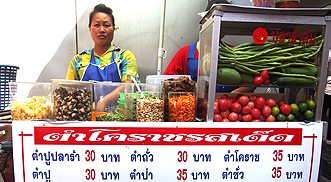
Ninety seconds later, out comes a heartbreaking version of pad kha-prao: roughly ground pork and wilted leaves of holy basil, spiked lavishly with chilies and a beautiful sheen of fish sauce, a violently fried egg resting atop it all. Whatever expectations I have for the meal come not from the months of reading books and blogs before the trip, but in the seconds between ordering and eating.
With even the most rudimentary skills of observation you can sniff out an astounding meal on any block of the city. A few clues: Is that wok firing especially hot? Is she cooking to order, rather than scooping out the warmed-over creations cooked hours prior? (The latter is, of course, the only way to serve many of Thailand’s great dishes—jungle curries, tom yum—but if it’s a dish that comes from the wok or the fryer, it should burn your lips with the first bite). Is the cook’s prep area well stocked with vegetables, herbs and protein? Is the menu short? Better yet, is there no menu at all?
When it comes to density and intensity, Bangkok is unrivaled in the world of street food. Next to the wild tastes of Bangkok, the hawker flavors of Singapore seem domesticated. Take my 3 am nightcap at the Huay Kwang Market. After a round of beers and sundried pork that has a sweetness and chew stranded perfectly between satay and jerky, I order a plate of raw prawns. The fat crustaceans are plucked live from a fish tank, summarily executed, shelled and butterflied on the spot. They are then slathered in what looks like pesto and buried under tufts of fresh herbs and nickel-size circles of raw garlic. Everything looks so fresh and innocent… and then you bite down. First, a rush of sweetness from the shrimp, then a sharp hit of garlic, and finally, blackout levels of spice from the puree of green chilies painted onto the crustaceans. It takes two large Chang beers to extinguish the fire.
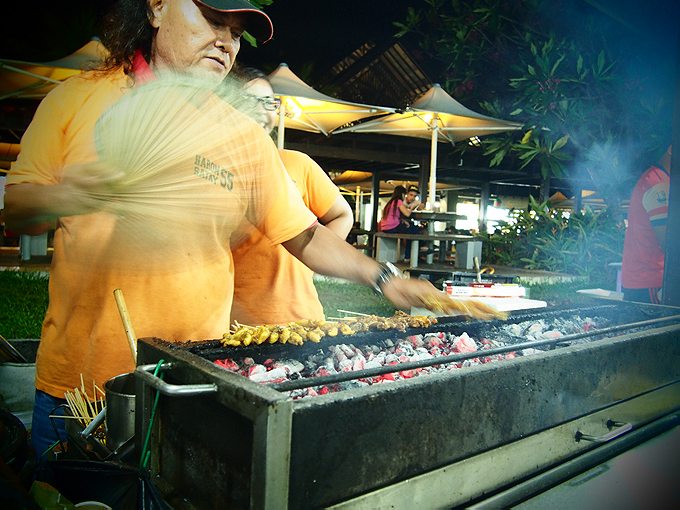
Thai food is a high-wire balancing act, one that pits salty, sour, sweet and hot against each other in equal and opposite measures. Ever wonder why you find yourself so consistently disappointed with Thai food in places that aren’t Thailand? Out of fear of offending sensitive Western palates, the kitchen holds back on the heat, they pull back on the fish-sauce punch, and the whole dish falls apart.
But it’s not just the impossible juxtaposition that makes Thai street food so special. Thai street cooks, like great restaurant chefs, know the value of the little touches that take a dish over the top: the leaves of crunchy fried holy basil that add texture to a salad, the crust of coconut encasing molten chunks of fried bananas, the drizzle of vinegar infused with chilies and lemongrass that makes your whole body buzz.
The unspoken agreement between cook and eater: I give you condiments, don’t fuck up my creation.
To take those little touches one step further, street vendors empower eaters with a table full of condiments, turning you into a sous chef of sorts. Too spicy? A squeeze of lime and a dusting of sugar should curb the burn. Lacking punch? A splash of fish sauce and a spoonful of fresh chilies should fix that right up. It’s an unspoken agreement between cook and eater: I give you these tools, if you promise me you won’t fuck up my creation.
It’s one of my favorite parts of eating on this side of the world: I find myself constantly tinkering, dusting a midnight pad thai liberally with dried chilies, cutting the funk of a breakfast bowl of boiled offal with a few squeezes of lime, goosing a Chinese-style stir-fry of water spinach and pork belly with spicy vinegar and fish sauce.
A few meals into a trip to a place like Bangkok you begin to wonder how it ever got so good, how they cracked the code on one of gastronomy’s most enduring challenges: how to make food fast, healthy, inexpensive and unthinkably delicious all at the same time.
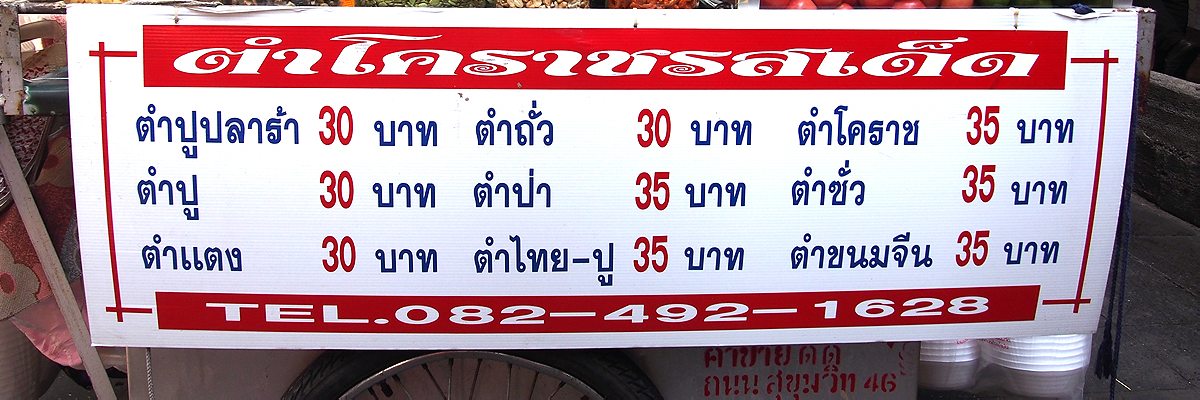
It starts with the fact that these countries have the building blocks: fresh produce of exceptional quality, cooking techniques developed and refined over millennia, potent condiments that can be combined in thousands of different ways to create vastly different effects. But just having the right paint isn’t enough to make a work of art. The proliferation of street food—in Thailand and Vietnam, just like in ancient Rome and Athens—is, by definition, an urban adaptation. When the bulk of Thailand’s population lived in rural villages, most meals were cooked and eaten at home, but as people began to swarm towards the cities in the mid to late 20th century, domestic life underwent radical changes. Urban kitchens were ill equipped for family cooking and busier lifestyles left little time to stand around the stove. Plus the economies of scale made eating out every bit as cheap as eating in. And while Mom might make a mean green curry or tom yum, it’s tough to compete with the legions of street cooks who dedicate their lives to making the same dish over and over until its part of their identity.
If the game is to eat one of the best meals of my life for as little money as possible, I’ve already won.
On my last afternoon in Bangkok, standing in front of a dizzying number of street vendors besides Siam Center, I decide to play a game. With a bus to catch in 20 minutes and unable to find my preprogrammed location, I set out to deposit my remaining 300 baht (about $10) into the hands of as many cooks as possible. I start with dessert: an old man covers a flattop with a dozen mini crepes, toasting them to a rich mahogany brown. The crepe itself is as thin and crunchy as a candy shell, the warm savory filling evoking the sweet, salty comfort of an American diner breakfast. A few stands down, a plump middle-aged woman cooks chicken meatballs: smooth, pale orbs threaded onto bamboo skewers, grilled until gently charred on the surface, then dipped into a crimson vat of sweet chili sauce and served with a few slices of cucumber. Next stop, som tam, the ubiquitous northern Thai salad of green papaya, chilies, and dried shellfish, pestle-pounded into an electric mix of spice and sweet and ocean umami.
If the game is to eat one of the best meals of my life for as little money as possible, I’ve already won, but I keep going: I still have a wad of bills in my pocket and the last stand in the line of vendors is the most enticing of the lot. A mother and daughter work in a tight formation, pulling chicken parts from their fish-sauce marinade, dredging them in flour, then dropping them into a vat of burbling fat. The chicken emerges with a craggy coat the color of maple syrup. By the time I board the bus five minutes later, it’s still too hot to handle without a napkin.
And so I sit there, lips blistered with chicken crackling, fingers singed with pounded capsaicin, watching the whole of Bangkok sink into the horizon behind me, smilingly stupidly, wondering what to do with the last 150 baht.
![]()
We sit down next to a woman on a street corner adjacent to the Ben Thanh Market in Saigon’s District 1. There is no stove, no cooking implements, no visible sign that she’s offering food of any sort. But after my friend orders in Vietnamese, she goes to work unpacking boxes and trays and tiny little cups filled with mysterious ingredients that seem to materialize on the spot. Slowly, a plate begins to take shape: first comes a soft ivory crepe made from rice flour, stuffed with ground pork and chunks of woodear mushrooms, then a thicket of pickled carrots and radish, next a scattering of fresh herbs and fried shallots, and finally, a few generous spoonsful of fish sauce. By the time she presents us with her creation, banh cuon, the plastic plate nearly snaps under the labor of a country’s worth of condiments. In that first bite I taste the whole of Vietnam: salt and sun and…
The life of a street vendor starts early. There are vegetables to buy, herbs to wash, bread to bake, noodles to boil. This being southern Vietnam, land of a million noodle soups, there are meats to braise and rich, complex stocks to simmer. Some of these are made in homes with functioning kitchens, others on portable stoves or over charcoal fires, but all, regardless of origin, will end up on a street corner somewhere, sold as fuel to a breakfasting businessman, as a respite for a weary cabbie, or as a gathering point for young Saigonese on the cusp of a big night.
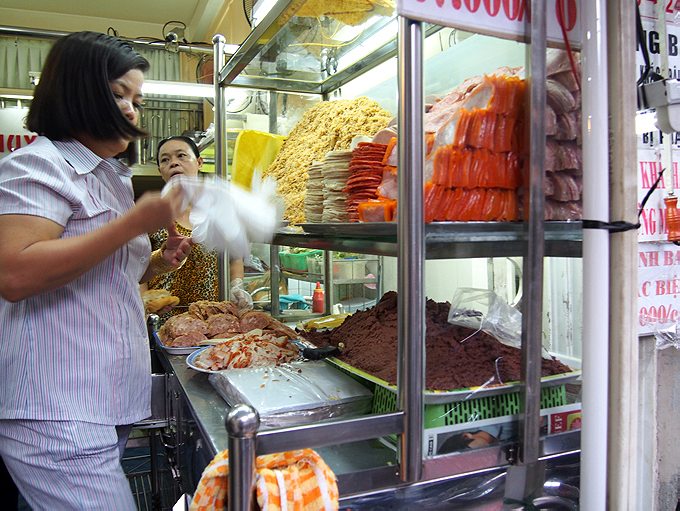
If Singapore stands as a crossroads of Eastern culinary traditions, and Bangkok’s identity is found in the delicate balance of flavor extremes, Saigon street food is about subtle elegance and sophistication, part of it left behind by French colonialism, part of it birthed from the Vietnamese’s own exacting standards.
Consider the series of meals I eat on my second day in Saigon: First, a bowl of chewy brown rice noodles, strewn with crab whose meat has been boiled and removed, cut with pork and herbs, turned into meatballs, then tucked back into the empty crab shells like a little surprise. Next, frog legs braised in yellow curry and holy basil, the kind of dish you might find for $23 at a Vietnamese fusion restaurant on the Lower East Side. Finally, to close out the day, a plate of grilled clams topped with scallions, peanuts, fish sauce and a drizzle of warm pork fat—a dish so good from a place so unassuming my brain immediately does summersaults. Beautiful grilled shrimp? Sure, I can process that. But a dish this sophisticated? You search for answers: Who is behind the stove? What type of training does he or she have? How the hell did they come up with this idea? Why am I the only person among the 20 or so scattered on the sidewalk currently eating it? None of it really adds up, but nothing in Vietnam does. You should hate this city—for the crowds, the noise, the heat, the smell—but your heart sinks deeper into your stomach when you realize someday soon you must leave it.
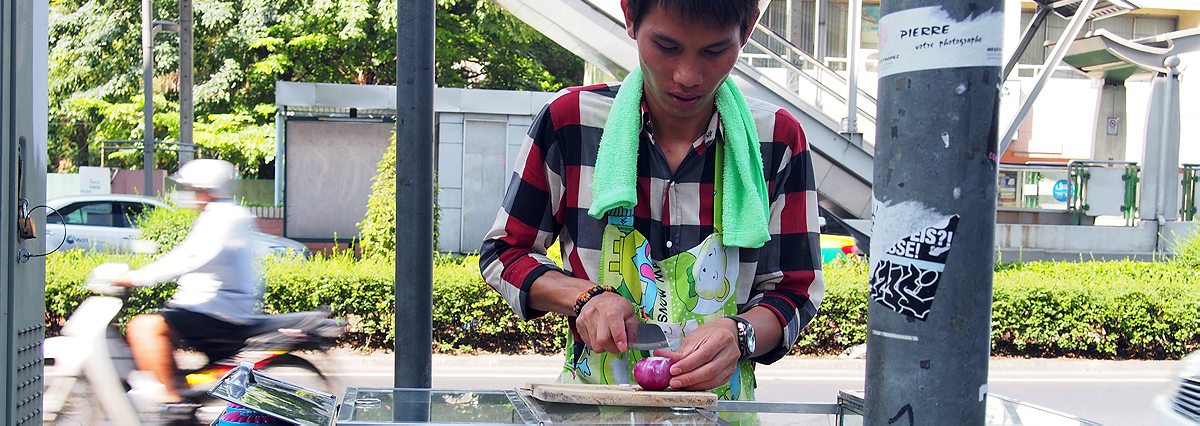
Few places in Asia have changed more over the past decade than Saigon. A growing economy has given birth to a new middle class and opened up the country to foreign investment. Starbucks premiered in Saigon to rock-star crowds earlier this year, and Vietnam’s first McDonald’s is slated for 2014. But despite the foreign invaders, these changes have strengthened the food scene, not diluted it. During my time here I twice break down and eat inside a real restaurant. The first, at the stylish Ngo Nho Pho Nho (where I share a bamboo table with last year’s Miss Vietnam), serves up an electric version of bun dau, a northern spread of rice noodles, tofu, pork sausage and various herbs and condiments. The second, the well-oiled Quan Nem in District 1, makes easily the best crab spring rolls I’ve ever eaten. All of this serves to confirm a long-held suspicion: If I had to choose once city in which to spend my last day on earth eating, it would be Saigon.
With every bite I grow more attached. After a day or two, you settle into a rhythm: Not long after the sun scatters across the city, you find yourself hovering over a bowl of pho bo. You tear tender lettuces and jagged leaves of sawtooth coriander and set them afloat in the steaming broth. As you slurp your way to the bottom, currents of star anise and boiled beef wash over you. In the dead heat of the early afternoon, you seek solace in the cooling crunch of a bahn mi. You time your visit, like most of the locals, to the day’s second round of fresh baguettes, which swell like soufflés when they’re just out of the oven. The first bite is sweet with carrot and cured pork, the second dominated by chili heat; the dance goes on until you discard the newspaper the sandwich came wrapped in. Afterwards, you pull up a stool down the street where the old woman has finessed her 10 words of English into the beginnings of a loyal partnership. Her ice is better than her competitors, so her ca phe sua da stays cold and sweet and strong enough to sip it slow. You think about ordering a second, but Vietnamese coffee is a hard drug and your hands are already shaking with caffeine.
The bottles of Bia Saigon stack up like mollusk shells as the night slowly slips away.
If breakfast and lunch are quiet affairs that carry you through the day, dinner is a way to kill the night. In District 1, you and your rabble, a few drinks deep, gather around a seafood stall and point at the rainbow assortment of shellfish. The young woman scoops the sparkling seafood from metal bowls while her husband fans the charcoal bed they are destined for. Soon after, a plate of blood cockles arrives bathed in a dark, sticky tamarind glaze. Then razor clams, speckled with chunks of garlic and basil. Then mussels, green with scallion oil. The bottles of Bia Saigon stack up like mollusk shells as the night slowly slips away.
When you finally waddle home, belly full of lager and ocean protein, you wonder how you’ll ever be able to go back to eating the way you did before. Do these people have any idea how good they have it? How do you say that in Vietnamese?
Context and environment have a profound impact on how we experience food, but there is something else that makes this way of eating so vital, something beyond the scooter cries and the tiny stools and the mugs of iced beer. It’s the face of the wok that has seared millions of meals into submission. It’s the fact that not one motion is wasted in transforming that pile of vegetables and meat into a beautiful plate of food. It’s the years of cooking the same dish over and over until the pan handles and the spatula rivets have worn away at your skin like a river rounding out the edges of a stone. That doesn’t travel; that doesn’t translate.
That stays on the streets, exactly where it began and where it belongs.